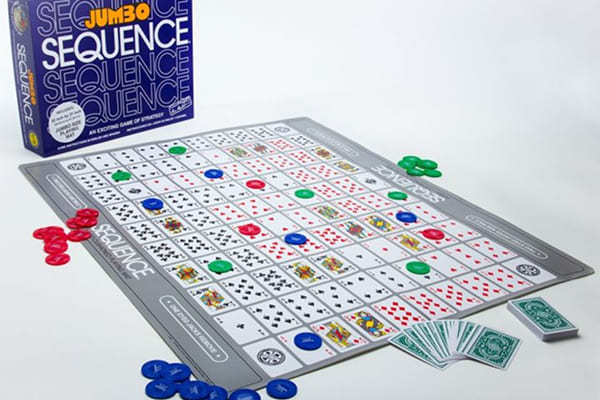Sequence

Sequence
Play a card. Place a chip. Connect five in a row. Sequence is part board game, part card game, and totally addictive.
In Sequence, players play cards from a standard deck and place chips on a matching card space on the game board. The goal? Form a sequence — five chips in a row — while blocking your opponents. It’s a blend of planning, luck, and tactical timing.
How to Play Sequence
Sequence uses a board covered in two standard 52-card decks (excluding jokers). Each player has a hand of cards and takes turns building sequences:
- Setup: Shuffle the deck. Deal cards depending on player count (usually 7 per player).
- Play a Card: On your turn, play one card and place a chip on a matching card space on the board.
- Draw a Card: Draw a card from the deck to end your turn. Hand size stays constant.
- Jacks: Two-eyed jacks are wild (play anywhere). One-eyed jacks remove an opponent’s chip.
- Form a Sequence: A sequence is five chips in a straight line (horizontally, vertically, or diagonally).
- Winning: The first team to form 2 sequences (or 1 in a 2-player game) wins!
➤ Some versions include team-based rules — communication is not allowed during gameplay, so strategy is silent!
Core Mechanics
Sequence’s mechanics combine luck of the draw with spatial planning. Here's what makes it click:
🃏 Card Matching
Every card in your hand represents a move on the board. But each card appears twice — timing is everything.
🧠 Grid Strategy
Players must visualize multiple threats, block opponents, and align chips across a shared board.
👥 Silent Team Play
In teams, you can't speak — you must “read” your teammate’s intentions and support them without coordination.
🎯 Special Cards
Jacks change the game: wild jacks enable combos, while one-eyed jacks disrupt enemy plans.
Beginner Tips
Sequence is easy to pick up, but these tips can help you stay ahead in your early games:
- 1. Use the corners wisely.
Corner spaces are wild — include them in sequences whenever possible. - 2. Always check for doubles.
Each card appears twice on the board. Choose the better placement. - 3. Block efficiently.
If an opponent has 3 or 4 in a row, stop them even if it delays your own sequence. - 4. Save your jacks.
Wild and removal cards are powerful — use them at key moments, not immediately. - 5. Pay attention to diagonals.
New players often miss these — but they’re sneaky and effective for surprise wins.
Game Variants
Sequence is great for all group sizes — but a few small tweaks can increase variety and fun:
- 🎭 Bluffing Mode: Allow table talk in team games. Adds deception and traps — great for experienced players.
- 🧱 Wall Mode: Once a sequence is complete, chips in it can’t be used in new sequences (house rule).
- ♟️ Multi-Sequencing: Allow overlapping sequences using shared chips for quicker games with 6+ players.
- 👪 Family Mode: Allow open hands and suggestions for younger players learning the game.
➤ Sequence is adaptable — whether competitive or casual, you can shape the game to fit your group.